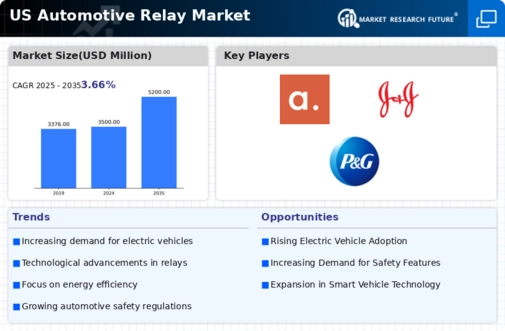Rising Demand for Electric Vehicles
The automotive relay market experiences a notable boost due to the increasing demand for electric vehicles (EVs) in the US. As manufacturers pivot towards EV production, the need for advanced relay systems becomes paramount. These systems are essential for managing high-voltage circuits and ensuring efficient power distribution. In 2025, the EV market is projected to account for approximately 25% of total vehicle sales in the US, which directly correlates with the growth of the automotive relay market. This shift necessitates the development of specialized relays that can handle the unique requirements of electric drivetrains, thereby driving innovation and investment in the automotive relay market.
Increased Focus on Vehicle Electrification
The automotive relay market is experiencing growth due to the increased focus on vehicle electrification. As automakers transition from traditional internal combustion engines to hybrid and fully electric vehicles, the demand for reliable and efficient relay systems rises. These systems are crucial for managing the electrical loads associated with electrified powertrains. In 2025, it is estimated that hybrid and electric vehicles will represent over 30% of new vehicle sales in the US. This shift towards electrification necessitates the development of specialized relays that can handle higher currents and voltages, thereby propelling the automotive relay market forward.
Regulatory Compliance and Environmental Standards
The automotive relay market is also shaped by stringent regulatory compliance and environmental standards in the US. As the government enforces regulations aimed at reducing emissions and enhancing vehicle safety, manufacturers are compelled to adopt advanced relay technologies. These technologies not only help in meeting compliance but also contribute to the overall efficiency of vehicles. For example, relays that support energy-efficient systems can play a crucial role in reducing a vehicle's carbon footprint. The automotive relay market is likely to see increased demand as manufacturers strive to align with these regulations, which are expected to become more rigorous in the coming years.
Growth of Advanced Driver Assistance Systems (ADAS)
The automotive relay market is positively impacted by the growth of Advanced Driver Assistance Systems (ADAS) in the US. As consumer demand for safety features rises, automakers are increasingly incorporating ADAS technologies into their vehicles. These systems rely heavily on relays to manage various functions, such as braking, steering, and collision avoidance. By 2025, the ADAS market is projected to grow at a CAGR of 15%, which suggests a corresponding increase in the demand for automotive relays. This trend indicates that manufacturers must innovate and produce relays that can support the complex functionalities of ADAS, thereby driving growth in the automotive relay market.
Technological Advancements in Automotive Electronics
Technological advancements in automotive electronics significantly influence the automotive relay market. The integration of sophisticated electronic control units (ECUs) in vehicles enhances functionality and performance, leading to a higher reliance on relays for various applications. For instance, modern vehicles utilize relays for functions such as lighting, climate control, and safety systems. As of 2025, the automotive electronics market is expected to reach $300 billion in the US, indicating a robust growth trajectory. This growth is likely to propel the automotive relay market, as manufacturers seek to develop relays that can support advanced features and improve overall vehicle efficiency.














Leave a Comment